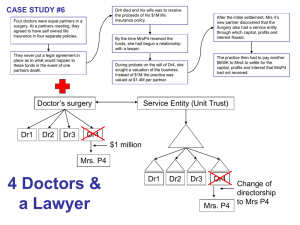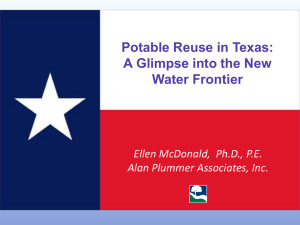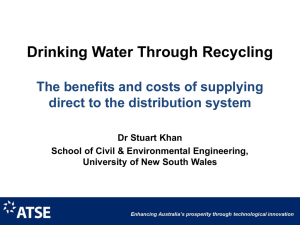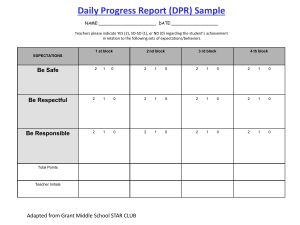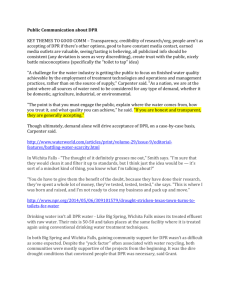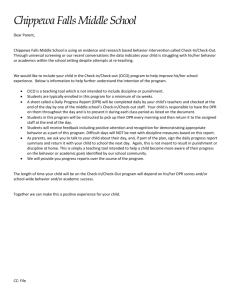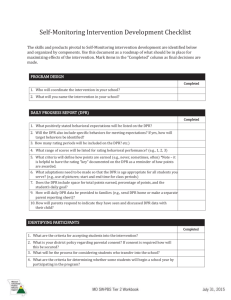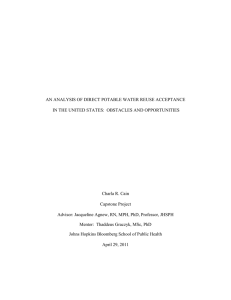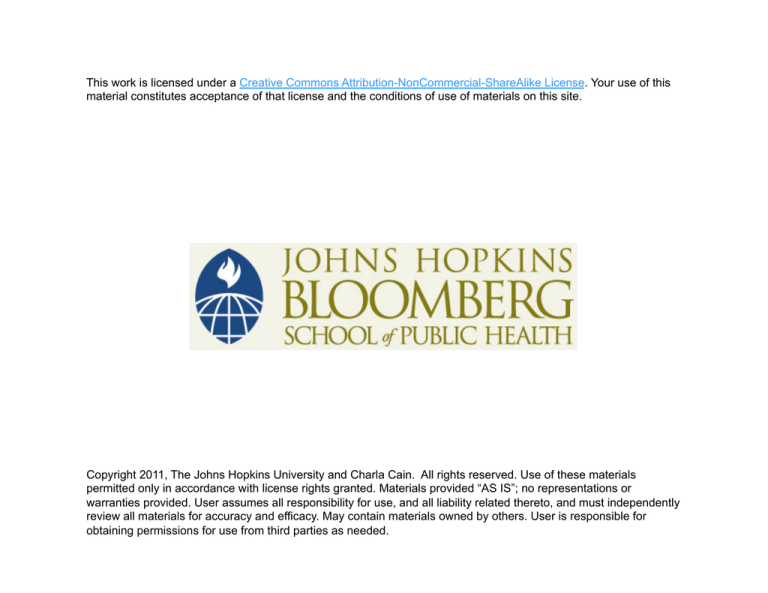
This work is licensed under a Creative Commons Attribution-NonCommercial-ShareAlike License. Your use of this
material constitutes acceptance of that license and the conditions of use of materials on this site.
Copyright 2011, The Johns Hopkins University and Charla Cain. All rights reserved. Use of these materials
permitted only in accordance with license rights granted. Materials provided “AS IS”; no representations or
warranties provided. User assumes all responsibility for use, and all liability related thereto, and must independently
review all materials for accuracy and efficacy. May contain materials owned by others. User is responsible for
obtaining permissions for use from third parties as needed.
An Analysis of
Direct Potable Water Reuse Acceptance
in the United States:
Obstacles and Opportunities
Charla R. Cain
MPH Capstone Project
May 2011
Advisor: Jacqueline Agnew, RN, MPH, PhD, Professor, JHSPH
Mentor: Thaddeus Graczyk, MSc, PhD
Johns Hopkins Bloomberg School of Public Health
Presentation Outline
Introduction
Description of Potable Water Reuse – Indirect and Direct
Drivers of Direct Potable Reuse
ADWT Treatment Train
Case Studies
Obstacles and Opportunities
Treatment Train Unit Processes
Health Risk Concerns
Key Regulations
Public Perception
Management and Operational Controls
Conclusion
Introduction
Dependable supply of safe drinking water
Status quo – conventional drinking water treatment
Indirect Potable Reuse (IPR) – successful in U.S., 30yrs
Direct Potable Reuse (DPR) – most sustainable option
Has DPR’s time now come?
Survey current literature
Illuminate problem of DPR acceptance
Report on opportunities to go forward
Indirect Potable Water Reuse
Unplanned
IPR
Wastewater
Treatment
Plant
jjkj
Planned
Water
Reclamation
plant
Wastewater
Treatment
Plant
Drinking water
Treatment
Plant
Adapted from: Asano, T. et. al. Water Reuse. 2007. p. 1307
IPR
Drinking water
Treatment
Plant
Direct Potable Reuse
Water
Reclamation
plant
Drinking water
Treatment
plant
Wastewater
Treatment
plant
Adapted from : Asano, T. et. al. Water Reuse. 2007. p 1307
“The introduction of highly
treated reclaimed water either..
directly into the potable water
distribution system
downstream of a water
treatment plant, (i.e., pipe-topipe)
or
into the raw water supply
immediately upstream of a
water treatment plant.”
Drivers of DPR
Global
water situation
Water-scarce
Population
/ water-stressed areas
increases / demographic shifts
Environmental
Right
to Water
Impacts
Advanced Drinking Water
Treatment (ADWT)
Secondary effluent
Tertiary treatment
(pretreatment for
advanced
processes)
Ozonation
PAC
MF/UF
Filtration
UV disinfection
Dissolved constituents
removal, conditioning
GAC / BAC
Ion Exchange
RO
AOP
Water conditioning / pH
Disinfection
Chlorine
UV
Ozone
HOME
ADWT Targets
Inorganics (i.e. nitrogen, sulfides, heavy metals)
Organics (i.e. Benzene, DDT, carbon tetrachloride)
Membrane Bioreactor, Reverse Osmosis
Microorganisms (bacteria, viruses, protozoa, helminthes)
Membrane Bioreactor, Reverse Osmosis
Membrane Bioreactor, Disinfection (chlorine, UV, ozone)
Endocrine Disrupting Compounds (i.e. Estradiol,
Progesterone) and Pharmaceuticals and Personal Care
Products (i.e. Hydrocodone, Dilantin, Deet)
Reverse Osmosis and UV/Advanced Oxidation Process
Note: MBR includes PAC, GAC, BAC, UF/MF/NF
Case Study – Windhoek, Namibia
Only DPR location in world!
Opened 1969, upgraded 2002
Multiple Barrier Approach
Oversight by leading water
treatment agencies
New Goreangab Water
Reclamation Plant
Source: http://www.en.wikipedia.org/wiki/File:Windhoek_Skyline.jpg
Source: http://www.fichtner.de/en/water_supply_projects.html
Case Study - Singapore
Used Water
Microfiltration
Reverse Osmosis
Disinfection with UV light
NEWater
DPR – Current Dialogue
Media
/ Government
Wall Street Journal
EPA’s Office of Water
Scientific
Researchers
NWRI DPR regulation white paper, CA
2010 DPR Workshop Report, CA
Public
Health Researchers
JHSPH and wastewater reuse
WateReuse
Association
WateReuse Symposium DPR presentations
Determinants of DPR Acceptance
Treatment Train
Processes
Health Risk
Concerns
Management
and Operational
Controls
Key Regulatory
Issues
Cost
Treatment Train - Obstacles
Logistical
Difficulties
Membrane
Sensitivity
Disinfection
Waste
Byproducts
Stream Generation
Treatment Train - Opportunities
Increased
Research and Development
Example: Endocrine Disrupting Compounds and
Pharmaceuticals and Personal Care Products
2010
DPR Workshop Report
Classification of best treatment process order
Identification of Chemicals of Emerging Concern
(CEC) surrogates
Validation of barrier effectiveness against
benchmarks
Health Risk Concerns - Obstacles
Few
Epidemiologic and Toxicological potable
reuse studies in IPR and DPR
Difficulties
extrapolating IPR epidemiologic
studies to DPR
Long-term
CECs
health effects difficult to assess
Health Risk Concerns - Opportunities
Perform
epidemiologic studies of DPR and
potential health effects
2010
DPR Workshop Report
Water quality treatment performance goals
Validation of treatment performance goals through
performance monitoring
Health risk and exposure assessments
Monitoring for public health assurance
Key Regulations - Obstacles
SDWA
No
U.S. Federal regulations for IPR or DPR
U.S.
Federal guidelines for IPR only
State
No
and CWA insufficient for DPR regulation
regulations for IPR - 4 states only
state regulations or guidelines for DPR
Key Regulations - Opportunities
EPA
to include DPR chapter in next Guidelines
for Water Reuse
California
leader
2010 NWRI White Paper
2010 DPR Workshop Report
Identify optimal regulatory scheme
Develop CEC evaluation approach
Assess environmental buffer function
Develop source control strategy
Public Perception - Obstacles
Largest
hurdle
No
separation between sewage effluent and
drinking water influent
Media
“From toilets to tap: How we get tap
water from sewage” USA Today, Kathy Chu
http://www.usatoday.com/money/industries/environment/
2011-03-03-1Apurewater03_CV_N.htm#
Water
is “everywhere” and therefore DPR not
necessary
Public Perceptions - Opportunities
Utilize
identified factors influencing public
perceptions and behavioral acceptability
2010
DPR Workshop Report
Develop appropriate terminology
Survey stakeholders and involve at inception
Utilize health communication specialists to develop
messages and strategy
“Trust”
= strongest influencing factor. Capitalize!
Management & Operational Controls –
Obstacles and Opportunities
Real-time
Control
2010
process monitoring
strategies development
DPR Workshop Report
Consider system design for emergency response
Develop enhanced source control programs
Develop DPR operational guidelines
Conclusion
Direct
Potable Reuse….
Viable option for future water resource management
Acceptance depends on pursuing opportunities
Need for stronger epidemiologic research
California as a model
“When
the well is dry, we learn the worth of water.”
Benjamin Franklin, (1706-1790), Poor Richard’s Almanac, 1746
Thank You…
For a thirst-free future…
…your kids will thank you!
www.thirstfreefuture.com
References
Intro
http://www.battelle.org
IPR / DPR
Asano, T.; Burton, F.L.; Leverenz, H.L.; Tsuchihashi, R.; Tchobanoglous, G. Indirect Potable Reuse
through Surface-Water Augmentation. Chapter 23. In: Water Reuse: Issues, Technologies, and
Applications. New York: Metcalf & Eddy, Inc., 2007: p.1307 & 1346.
Windhoek, Namibia
http://www.fichtner.de/en/water_supply_projects.html
http://www.hivresponse.gov.na
http://www.en.wikipedia.org/wiki/File:Windhoek_Skyline.jpg
Singapore
http://www.livetradingnews.com/barclays-offers-rmb-bond-fund-in-singapore-39050.htm
http://www.ambsingapore.um.dk/en/menu/CommercialServices/MarketOpportunities/Sectoranalyses/
Energy+and+Environment/
http://www.greatnewplaces.com/t-Sembcorp
Key Regulations – Opportunities
http://nwri_usa.org
Public Perceptions – Obstacles
http://worldchanging.com
http://www.usatoday.com/money/industries/environment/2011-03-03-1Apurewater03_CV_N.htm#

